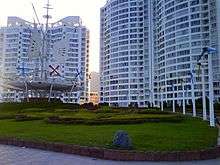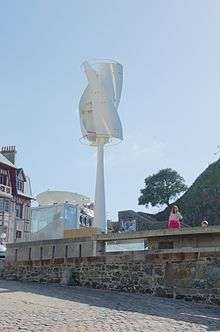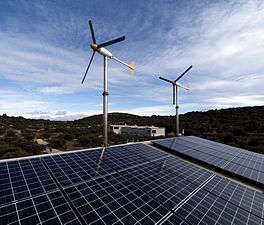Small wind turbine

A small wind turbine is a wind turbine used for microgeneration, as opposed to large commercial wind turbines, such as those found in wind farms, with greater individual power output. The Canadian Wind Energy Association (CanWEA) defines "small wind" as ranging from less than 1000 Watt (1 kW) turbines up to 300 kW turbines.[1] The smaller turbines may be as small as a 50 Watt auxiliary power generator for a boat, caravan, or miniature refrigeration unit. The IEC-61400-2:2006 Standard defines small wind turbines as wind turbines with a rotor swept area smaller than 200 m2, generating at a voltage below 1000 Va.c. or 1500 Vd.c.
Design
Smaller scale turbines for residential scale use are available. Their blades are usually 1.5 to 3.5 metres (4 ft 11 in–11 ft 6 in) in diameter and produce 1-10 kW of electricity at their optimal wind speed.[1] Some units have been designed to be very lightweight in their construction, e.g. 16 kilograms (35 lb), allowing sensitivity to minor wind movements and a rapid response to wind gusts typically found in urban settings and easy mounting much like a television antenna. It is claimed, and a few are certified, as being inaudible even a few feet (about a metre) under the turbine.
The majority of small wind turbines are traditional horizontal axis wind turbines,[2] but vertical axis wind turbines are a growing type of wind turbine in the small-wind market. Makers of vertical axis wind turbines such as WePower, Urban Green Energy, Helix Wind, and Windspire Energy, have reported increasing sales over the previous years.
The generators for small wind turbines usually are three-phase alternating current generators and the trend is to use the induction type. They are options for direct current output for battery charging and power inverters to convert the power back to AC but at constant frequency for grid connectivity. Some models utilize single-phase generators.[3][4]
Some small wind turbines can be designed to work at low wind speeds,[5] but in general small wind turbines require a minimum wind speed of 4 metres per second (13 ft/s).[6]
Dynamic braking regulates the speed by dumping excess energy, so that the turbine continues to produce electricity even in high winds. The dynamic braking resistor may be installed inside the building to provide heat (during high winds when more heat is lost by the building, while more heat is also produced by the braking resistor). The location makes low voltage (around 12 volt) distribution practical.
Small units often have direct drive generators, direct current output, lifetime bearings and use a vane to point into the wind. Larger, more costly turbines generally have geared power trains, alternating current output and are actively pointed into the wind. Direct drive generators are also used on some large wind turbines.
Installation
Turbines are often mounted on a tower to raise them above any nearby obstacles. One rule of thumb is that turbines should be at least 9 m (30 ft) higher than anything within 150 m (490 ft).[7] Better locations for wind turbines are far away from large upwind obstacles. Measurements made in a boundary layer wind tunnel have indicated that significant detrimental effects associated with nearby obstacles can extend up to 80 times the obstacle's height downwind.[8] However, this is an extreme case. Another approach to siting a small turbine is to use a shelter model to predict how nearby obstacles will affect local wind conditions. Models of this type are general and can be applied to any site. They are often developed based on actual wind measurements, and can estimate flow properties such as mean wind speed and turbulence levels at a potential turbine location, taking into account the size, shape, and distance to any nearby obstacles.[9]
A small wind turbine can be installed on a roof. Installation issues then include the strength of the roof, vibration, and the turbulence caused by the roof ledge. Small-scale rooftop turbines suffer from turbulence and rarely generate significant amounts of power, especially in towns and cities.[10]
Markets
Japan
In July 2012, a new feed-in tariff approved by Japanese Industry Minister Yukio Edano went into effect, promising to boost the country's production of wind and solar energy production. The country is aiming to increase renewable energy investment in part as a response to the Fukushima radiation crisis in March 2011.[11] The feed-in tariff applies to solar panels and small wind turbines and requires utilities to buy back electricity generated from renewable energy sources at government-established rates.
Small-scale wind power (turbines of less than 20 kW capacity) will be subsidized at least 57.75 JPY (about 0.74 USD per kwh).[12]
United Kingdom
Properties in rural or suburban parts of the UK can opt for a wind turbine with inverter to supplement local grid power. The UK's Microgeneration Certification Scheme (MCS) provides feed-in tariffs to owners of qualified small wind turbines.[13]
United States
Small wind turbines added a total of 17.3 MW of generating capacity throughout the United States in 2008, according to the American Wind Energy Association (AWEA). That growth equaled a 78% increase in the domestic market for small wind turbines, which are defined as wind turbines with capacities of 100 kW or less. AWEA's "2009 Small Wind Global Market Study", published in late 2009 May, credited the increase in part to greater manufacturing volumes, as the industry was able to attract enough private investment to finance manufacturing plant expansions. It also credited rising electricity prices and greater public awareness of wind technologies for an increase in residential sale. But a poll of small wind manufacturers found that the growth in 2008 might be only a glimmer of things to come, as the companies projected a 30-fold growth in the U.S. small wind market within as little as five years, despite the global recession. The U.S. small wind industry also benefits from the global market, as it controls about half of the global market share. U.S. manufacturers garnered $77 million of the $156 million that was spent throughout the world on small wind turbine installations. A total of 38.7 MW of small wind power capacity was installed globally in 2008.[14]
In the United States, residential wind turbines with outputs of 2–10 kW, typically cost between US$12,000 and US$55,000 installed (US$6 per watt), although there are incentives and rebates available in 19 states that can reduce the purchase price for homeowners by up to 50 percent, to $3 per watt.[15] The US manufacturer Southwest Windpower estimates a turbine to pay for itself in energy savings in 5 to 12 years.[16][17]
The dominant models on the market, especially in the United States, are horizontal-axis wind turbines.
To enable consumers to make an informed decision when purchasing a small wind turbine, a method for consumer labeling has been developed by IEA Wind Task 27 in collaboration with IEC TC88 MT2. In 2011 IEA Wind published a Recommended Practice, which describes the tests and procedures required to apply the label.[18]
Croatia
Croatia is an ideal market for small wind turbines due to Mediterranean climate and numerous islands with no access to the electric grid. In winter months when there is less sun, but more wind, small wind turbines are a great addition to isolated renewable energy sites (GSM, stations, marinas etc.). That way solar and wind power provide consistent energy throughout the year.
Germany
In Germany the feed-in tariff for small wind turbines has always been the same as for large turbines. This is the main reason the small wind turbine sector in Germany developed slowly. In contrast, small photovoltaic systems in Germany benefited from a high feed-in tariff, at times above 50 Euro-Cent per kilowatt hour.
In August 2014 the German renewable energy law was adjusted, also affecting the feed-in tariffs for wind turbines. For the operation of a small wind turbine with a capacity below 50 kilowatt the tariff amounts to 8.5 Euro-Cent for a period of 20 years.
Due to the low feed-in tariff and high electricity prices in Germany, the economic operation of a small wind turbine depends on a large self-consumption rate of the electricity produced by the small wind turbine. Private households pay on average 28 cent per kilowatt hour for electricity (19% VAT included).
As part of the German renewable energy law 2014 a fee on self-consumed electricity was introduced in August 2014. The regulation does not apply to small power plants with a capacity below 10 kilowatt. With an amount of 1.87 Euro-Cents the fee is low.[20]
DIY construction
Some hobbyists have built wind turbines from kits, sourced components, or from scratch. DIY wind turbines are usually smaller (rooftop) turbines of approximately 1 kW or less.[21][22][23][24] These small wind turbines are usually tilt-up or fixed / guyed towers.[25][26]
Do it yourself or DIY-wind turbine construction has been made popular by magazines such as OtherPower and Home Power.[27]
Organizations as Practical Action have designed DIY wind turbines that can be easily built by communities in developing nations and are supplying concrete documents on how to do so.[28][29]
See also
References
- 1 2 Small Wind Turbine Purchasing Guide (PDF) (Report). Canadian Wind Energy Association. pp. 3–4. Archived from the original (PDF) on 2 March 2013. Retrieved 1 March 2016.
- ↑ Gipe, Paul. Wind energy basics: a guide to home- and community-scale wind energy systems. Chelsea Green Publishing, 2009. Accessed: 18 December 2010. ISBN 1-60358-030-1 ISBN 978-1-60358-030-4
- ↑ Forsyth, Trudy (20 May 2009). "Small Wind Technology" (PDF). National Renewable Energy Laboratory. Retrieved 20 September 2013.
- ↑ "Endurance E-3120-50 kW Wind Turbine from Endurance Wind Power". AZoNetwork. 13 May 2010. Retrieved 20 September 2013.
- ↑ Luleva, Mila (28 October 2013). "Small-Scale "Dragonfly" Wind Turbine Works at Low Wind Speeds". Green Optimistic. Retrieved 18 September 2015.
- ↑ Small Wind Turbine Purchasing Guide (PDF) (Report). Canadian Wind Energy Association. p. 6. Archived from the original (PDF) on 2 March 2013. Retrieved 1 March 2016.
- ↑ Hugh Piggott (6 January 2007). "Windspeed Measurement In The City". Scoraigwind.com. Retrieved 4 December 2011.
- ↑ "Wind tunnel measurements near an obstacle". Ntrs.nasa.gov. 15 October 2011. Retrieved 4 December 2011.
- ↑ "Development of a Neural Network based Obstacle Wake Model" (PDF). Retrieved 4 December 2011.
- ↑ Leake, Jonathan (2006-04-16). "Home wind turbines dealt killer blow". The Sunday Times. UK. Retrieved 2009-07-13.
- ↑ "Japan approves renewable subsidies in shift from nuclear power". Reuters. Retrieved 18 June 2012.
- ↑ "Japan Approves Feed-in Tariffs". Reuters. Retrieved 22 June 2012.
- ↑ "Feed-In Tariffs Scheme (FITs)". MCS. Retrieved 29 December 2012.
- ↑ "EERE News: AWEA: U.S. Market for Small Wind Turbines Grew 78% in 2008". Apps1.eere.energy.gov. Retrieved 4 December 2011.
- ↑ Shevory, Kristina (13 December 2007). "Homespun Electricity, From the Wind". The New York Times. Retrieved 4 December 2011.
- ↑ "Southwest Windpower". Windenergy.com. Archived from the original on 11 January 2012. Retrieved 4 December 2011.
- ↑ "Wind Power for Commercial Projects: Case Studies". XZERES. Retrieved 18 September 2015.
- ↑ "IEA Wind Home Page". Ieawind.org. Retrieved 4 December 2011.
- ↑ "Kako i zašto ostvarujemo najbolje rezultate" (in Hungarian). Veneko. Retrieved 18 September 2015.
- ↑ "German Small Wind Turbine Portal". klein-windkraftanlagen.com. Retrieved 4 February 2015.
- ↑ "British Wind and Energy Agency's DIY wind turbines page". Bwea.com. Archived from the original on 4 December 2011. Retrieved 4 December 2011.
- ↑ "Common FAQs of wind turbine construction and info for proper building". Wind-turbine-24v.com. Retrieved 4 December 2011.
- ↑ "Overview of wind turbine construction and info for proper building". Otherpower.com. Retrieved 4 December 2011.
- ↑ Diy wind turbine 1kw. Youtube. 7 May 2015. Retrieved 18 September 2015.
- ↑ "Smaller wind turbines usually of tilt-up or fixed design". Archived from the original on 1 October 2011. Retrieved 4 December 2011.
- ↑ "Modified Chispito Wind Turbine". Greenterrafirma.com. Retrieved 4 December 2011.
- ↑ "OtherPower and Home Power as popular diy microgeneration magazines" (PDF). Retrieved 4 December 2011.
- ↑ "Practical action producing info to construct DIY wind turbines for the developing world". Practicalaction.org. Retrieved 4 December 2011.
- ↑ "Basics on diy small scale windturbines and domestic power consumption" (PDF). Retrieved 4 December 2011.
Further reading
- Dan Fink; Dan Bartmann (2008). Homebrew Wind Power. Buckville Publications LLC. ISBN 0-9819201-0-1.
External links
| Wikimedia Commons has media related to Micro-generation wind turbines. |
- information about small wind market by WWEA
- Bladeless wind turbine
- A Dutch government test of 10 wind turbines (English summary: , )
- Make small wind turbine at home Complete video and image Guide by Newphysicist
- Challenges of Introducing Reliable Small Wind Turbines
- Fact sheet from the American Wind Energy Association
- Otherpower, a group of alternative energy enthusiasts
- An example of DIY small wind turbine


